Terrestrial Trunked Radio Market Size and Share
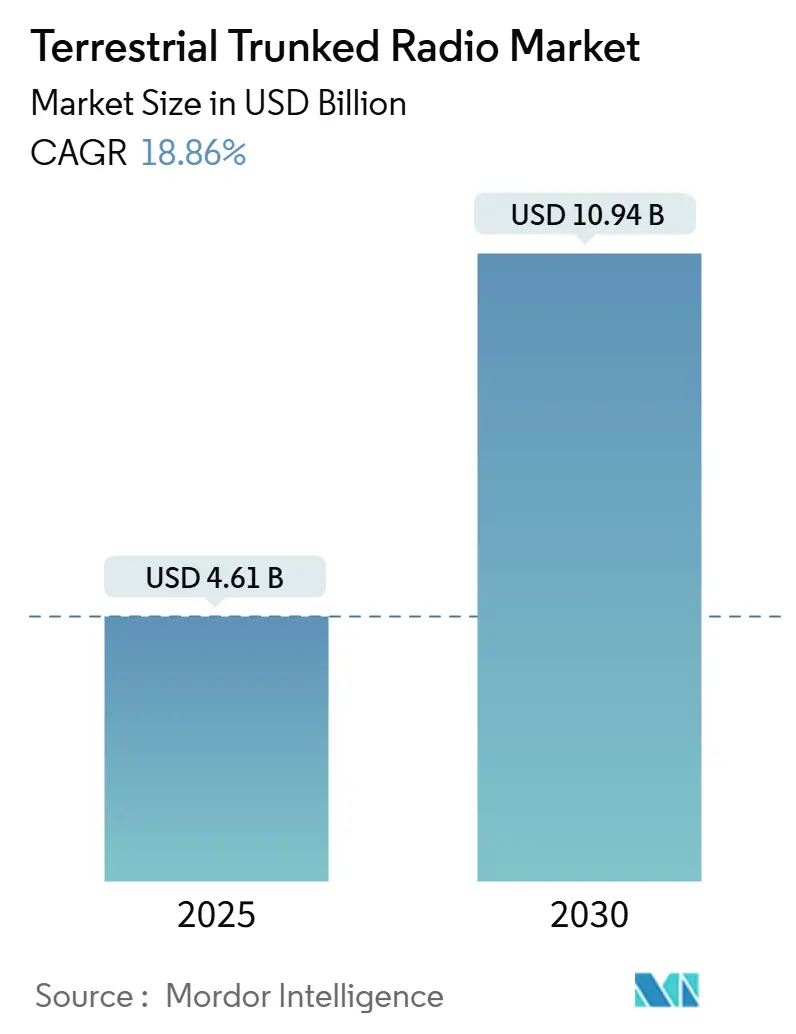
Terrestrial Trunked Radio Market Analysis by Mordor Intelligence
The Terrestrial Trunked Radio market stood at USD 4.61 billion in 2025 and is forecast to advance to USD 10.94 billion by 2030, reflecting an 18.86% CAGR. Growth is underpinned by government-mandated analog-to-digital migration, expanding hybrid TETRA-LTE roll-outs, and sustained smart-city funding that positions secure narrowband voice as a backbone for emerging broadband applications.[1]ETSI, “TETRA Security Algorithms,” etsi.org Spectrum refarming following 2G/3G switch-offs releases sub-1 GHz channels for critical private mobile radio, while Europe’s GBP 1.6 billion Emergency Services Network program signals an eventual shift from legacy TETRA toward broadband MCX platforms. Component upgrades, security algorithm refreshes, and IoT-ready gateways further stimulate replacement cycles, although high CAPEX and growing preference for full-broadband solutions temper uptake in cost-sensitive regions. Overall, the Terrestrial Trunked Radio market continues to expand as vendors combine mission-critical resilience with broadband data features to meet evolving first-responder and industrial requirements.
Key Report Takeaways
- By mode of operation, Trunked Mode Operation captured 63% of the Terrestrial Trunked Radio market share in 2024, while it is projected to post the fastest 19.56% CAGR through 2030.
- By component, infrastructure contributed 54% of the Terrestrial Trunked Radio market size in 2024; software and services is expected to expand at a 20.34% CAGR between 2025-2030.
- By access technology, TETRA Release 1 sustained a 71% revenue share in 2024, whereas hybrid TETRA-LTE systems are poised for a 20.67% CAGR to 2030.
- By frequency band, the 380–410 MHz allocation held 46% of the Terrestrial Trunked Radio market size in 2024; the 410–430 MHz band is projected to grow at 19.22% CAGR.
- By end-user, public safety and emergency services accounted for 33% of Terrestrial Trunked Radio market share in 2024; industrial and commercial applications lead growth at an 18.97% CAGR.
- • By geography, Europe led with a 41% share in 2024, while Asia Pacific represents the fastest-growing regional opportunity at 19.87% CAGR.
Global Terrestrial Trunked Radio Market Trends and Insights
Drivers Impact Analysis
| Driver | ( ) % Impact on CAGR Forecast | Geographic Relevance | Impact Timeline |
|---|---|---|---|
| Ultra-secure communications for first-responder convergence | +3.2% | North America and Europe | Medium term (2-4 years) |
| Analog-to-digital switch-off in 380–430 MHz band | +2.8% | Europe, expanding to APAC and MEA | Short term (≤ 2 years) |
| Smart-city grants funding hybrid TETRA-LTE roll-outs | +2.1% | North America and Europe, selective APAC | Medium term (2-4 years) |
| Expansion of private industrial campus networks | +1.9% | Global, resource-rich regions | Long term (≥ 4 years) |
| 2G/3G decommissioning freeing sub-1 GHz spectrum | +1.7% | Global, phased by regulator | Short term (≤ 2 years) |
| TETRA-IoT gateway integration for SCADA back-haul | +1.4% | Industrial regions worldwide | Long term (≥ 4 years) |
| Source: Mordor Intelligence | |||
Rising Need for Ultra-Secure Communications for First-Responder Convergence
Multi-agency response protocols broaden functional demands from voice toward encrypted data exchange and situational awareness. The UK Emergency Services Network targets more than 300,000 responders via hybrid TETRA-5G infrastructure for nationwide coverage by 2026.[2]UK Home Office, “Emergency Services Network Contract Awards,” gov.uk ETSI’s October 2022 release of TEA5–7 algorithms strengthens end-to-end encryption, addressing earlier vulnerabilities. Interoperability gateways that link legacy TETRA to broadband MCX now form a core procurement criterion, particularly in North American and European tenders where public-safety standards insist on high-assurance crypto. As agencies converge systems, vendors able to deliver backward-compatible yet broadband-ready terminals enjoy clear bidding advantages within the Terrestrial Trunked Radio market.
Accelerated Analog-to-Digital Switch-Off Mandates in 380–430 MHz Band
European regulators lead the charge in reclaiming analog spectrum, with several administrations setting 2026-2027 deadlines. The ITU’s 2025 Radio Regulations favor digital technologies and incentivize immediate infrastructure refresh across national networks.[3]International Telecommunication Union, “Radio Regulations 2025,” itu.intThese mandates trigger wave-on-wave equipment replacement and open capacity for interference-mitigated trunked deployments. As a result, synchronized procurement cycles emerge, boosting short-term revenues for system integrators across the Terrestrial Trunked Radio market.
Government Smart-City Grants Funding Hybrid TETRA-LTE Roll-Outs
Municipal modernization funds accelerate hybrid adoption. The U.S. SMART Grants Program disbursed USD 54 million to 34 projects in fiscal 2024 alone, each earmarking budget for interoperable communications that blend TETRA reliability with LTE data. Similar allocations under the EU Digital Europe Programme favor solutions capable of seamless mission-critical voice and broadband data. Grant support lowers entry barriers, spurring uptake among mid-sized cities and reinforcing the Terrestrial Trunked Radio market trajectory.
Expansion of Private Industrial Campus Networks (Ports, Mines, Airports)
Resource-intensive sectors adopt dedicated TETRA to improve operational continuity and safety. Rio Tinto’s 2024 purchase of additional radios for the Gudai-Darri mine highlights sustained industrial appetite for ruggedized narrowband systems. Large-scale campuses leverage centralized dispatch, GPS tracking, and SCADA back-haul to cut downtime and incident response times. These projects deliver long-tail service contracts that enhance recurring revenue streams for vendors within the Terrestrial Trunked Radio market.
Restraints Impact Analysis
| Restraint | ( ) % Impact on CAGR Forecast | Geographic Relevance | Impact Timeline |
|---|---|---|---|
| High CAPEX/OPEX versus PoC-over-cellular options | -2.3% | Global, cost-sensitive markets | Medium term (2-4 years) |
| Preference shift to full-broadband MCX solutions | -1.8% | Advanced markets and tech leaders | Long term (≥ 4 years) |
| Scarcity of harmonised spectrum in APAC and Africa | -1.2% | APAC core, Sub-Saharan Africa | Medium term (2-4 years) |
| Rising crypto-compliance costs (EAL4+) | -0.9% | Regulated and defense markets | Short term (≤ 2 years) |
| Source: Mordor Intelligence | |||
High CAPEX/OPEX Versus PoC-over-Cellular Alternatives
Push-to-Talk over Cellular leverages existing LTE infrastructure, offering lower upfront spend than purpose-built TETRA sites. Budget limitations in emerging markets heighten cost sensitivity, and semiconductor shortages further inflate radio prices. Nonetheless, resilience, direct-mode operation, and deterministic latency continue to justify TETRA for mission-critical contexts. Procurement teams increasingly split fleets, pairing low-tier PoC handsets with high-tier TETRA devices, a dynamic that narrows but does not eliminate growth in the Terrestrial Trunked Radio market.
Growing Preference for Full-Broadband MCX (LTE/5G) Solutions
3GPP releases add mission-critical push-to-talk, video, and data over LTE/5G, tilting some agencies toward broadband-first roadmaps. Samsung’s role in the UK Emergency Services Network underscores supplier momentum. Yet coverage, resilience, and QoS assurance in rural terrain lag narrowband performance, prompting many users to select hybrid terminals rather than pure LTE radios. As broadband maturity improves, hybrid architectures become the bridge that prolongs investment in the Terrestrial Trunked Radio market while preparing users for eventual migration.
Segment Analysis
By Mode of Operation: TMO Dominance Drives Network Efficiency
Trunked Mode Operation accounted for 63% of the Terrestrial Trunked Radio market in 2024, translating centralized channel control into spectrum efficiency for multi-agency dispatch. Usage is projected to climb at a 19.56% CAGR as smart-city deployments and large industrial campuses adopt trunked configurations. Direct Mode Operation remains essential where network independence is mandatory, such as disaster recovery or military missions, but its share grows more slowly. Enhanced TMO platforms now support dynamic handover to LTE, allowing crews to continue sessions outside TETRA footprint without manual intervention. Such flexibility keeps TMO well positioned within the Terrestrial Trunked Radio market.
Second-generation trunk controllers integrate GIS, telemetry, and AI-enabled dispatch analytics to optimize talk-group assignment and reduce channel congestion. Suppliers bundle these features with programable APIs, encouraging third-party application development. Mining firms and logistics hubs value these software hooks for automated vehicle coordination, further locking in TMO preference. Taken together, mode-of-operation trends signal that centralized spectrum stewardship will remain a critical differentiator through 2030.
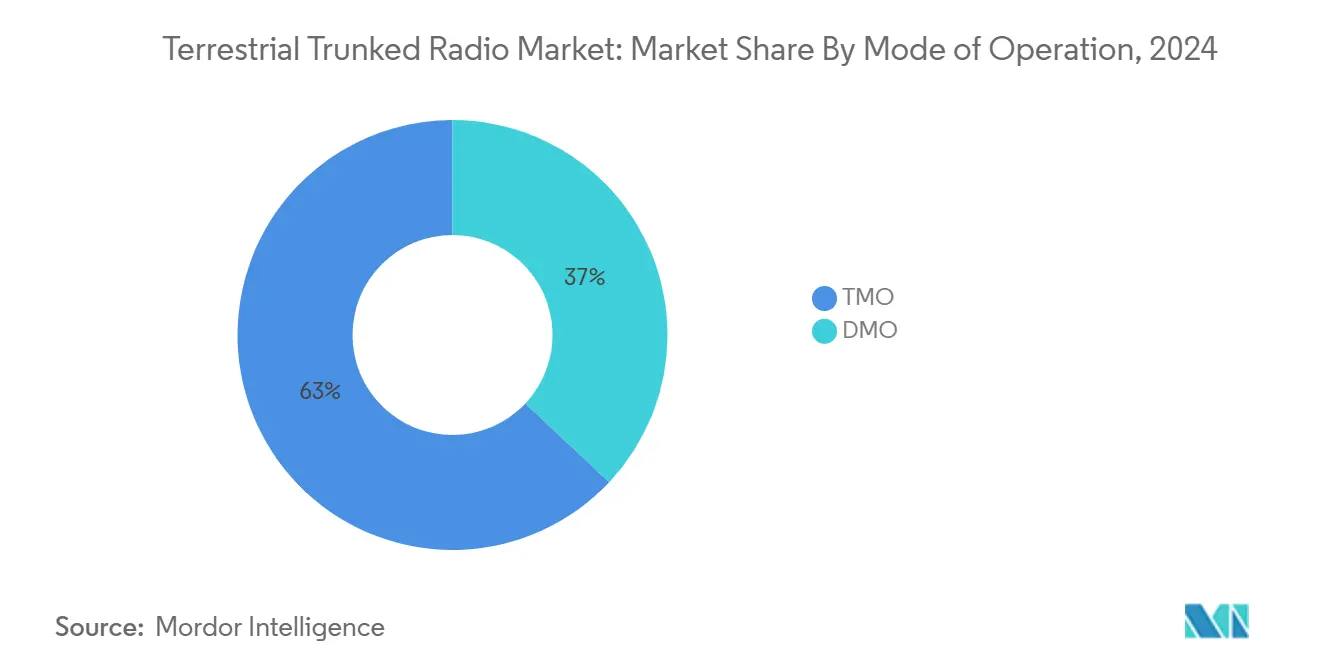
Note: Segment shares of all individual segments available upon report purchase
By Component: Infrastructure Foundation Supports Service Growth
Infrastructure captured 54% of 2024 revenues, underscoring the capital intensity of base-station, switch, and gateway deployment. As networks mature, service and software layers assume larger weight, expanding at a 20.34% CAGR. Platform suppliers now ship software-defined base stations that handle multiple bands via firmware, cutting truck-roll costs. Edge gateways translate TETRA traffic into IP, simplifying integration with enterprise resource planning and IoT dashboards and supporting a data-centric Terrestrial Trunked Radio market.
Terminal evolution favors ruggedized, IP68-rated devices with multi-standard modems and push-to-video capability. Battery energy-density gains extend shift life to 26 hours, reducing spares inventory. For operators, software-centric revenues such as over-the-air key management, predictive maintenance, and analytics subscriptions provide higher margins than hardware alone. Consequently, component mix is expected to tilt gradually from capex infrastructure toward opex services over the forecast horizon.
By Access Technology: Release 1 Legacy Meets Hybrid Innovation
TETRA Release 1 continues to serve 71% of installed lines thanks to proven voice reliability and a vast ecosystem of interoperable devices. However, hybrid TETRA-LTE systems headline growth at 20.67% CAGR. Release 2 (TEDS) offers up to 150 kbps but remains a transitional option for operators with moderate data needs. Hybrid portfolios combine narrowband voice with broadband data, permitting photo and video dispatch without sacrificing call setup times critical to field crews. This coexistence supports a gradual rather than disruptive technology refresh in the Terrestrial Trunked Radio market.
Field tests reveal that hybrid handhelds reduce device carry count by 30%, an operational win for fire and rescue services. At the platform layer, dynamic QoS orchestration routes voice over TETRA channels and high-bandwidth tasks over LTE, ensuring predictable user experience. Such architectural flexibility appeals to both public safety agencies pursuing broadband roadmaps and industrial sites requiring deterministic voice.
By Frequency Band: Harmonized Spectrum Drives 410–430 MHz Growth
The 380–410 MHz band retained 46% revenue share in 2024 due to its historical status as the harmonized allocation for public protection and disaster relief across Region 1. Continued growth in 410–430 MHz at 19.22% CAGR reflects operators seeking less congested channels for high-density metropolitan grids and interference-sensitive industrial sites. National regulators increasingly approve 410–430 MHz for expanded TETRA coverage, encouraged by ITU guidance that balances propagation advantages with equipment availability. Over the forecast period, coordinated release of 2×1.4 MHz blocks will enable capacity upgrades without impact on legacy user fleets.
Projects in Eastern Europe and Southeast Asia already specify 410–430 MHz for new public-safety networks, citing improved in-building penetration. Vendors respond with dual-band radios able to roam seamlessly between primary and expansion bands, thus protecting investments. As spectrum efficiency tools, such as adaptive channel allocation, mature, operators gain headroom to accommodate rising talk-group counts without substantial hardware additions.
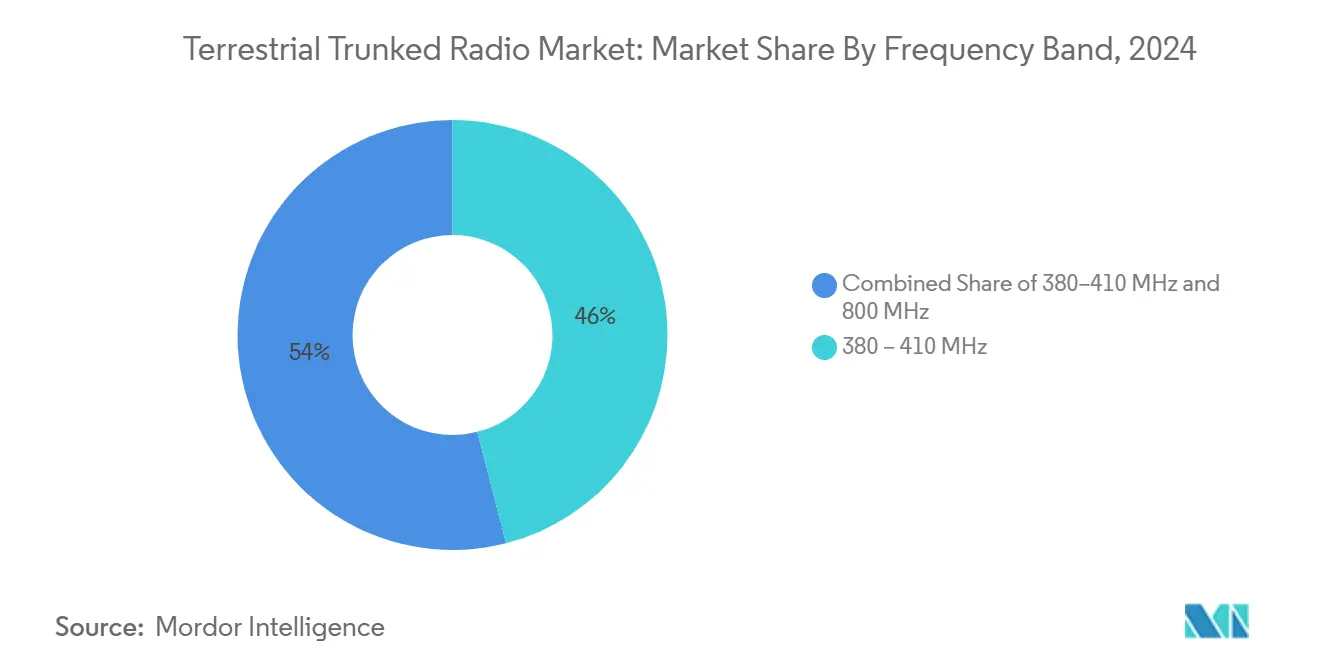
Note: Segment shares of all individual segments available upon report purchase
By End-User: Industrial Growth Challenges Public Safety Dominance
Public safety and emergency services represented 33% of the Terrestrial Trunked Radio market in 2024, grounded in life-critical voice mandates. Industrial and commercial users, spanning mining, oil and gas, utilities, and manufacturing, grow at an 18.97% CAGR as they embrace automation and site digitalization. Rail operators deploy TETRA for driver-guard communications and positive train control back-haul, while airports depend on trunked networks for ground handling and emergency coordination.
Utilities exploit telemetry integration to monitor substations and renewable energy assets, benefiting from TETRA’s deterministic latency. Defense sectors maintain specialized crypto and frequency-hopping variants, sustaining niche volumes. Collectively, broader enterprise adoption diversifies revenue sources and cushions suppliers against public-sector budget cycles, reinforcing demand across the Terrestrial Trunked Radio market.
Geography Analysis
Europe commanded 41% of 2024 revenues, bolstered by extensive legacy deployments and well-defined ETSI standards. Flagship networks such as Norway’s Nødnett, extended under a NOK 1.78 billion contract through 2031, illustrate long-term service revenue stability.[4]Motorola Solutions, “Investor Relations Q4 2024 Results,” motorolasolutions.com However, Europe now balances life-cycle extensions with migration planning as the UK progresses toward 5G-based emergency services. Funding constraints in certain member states and growing advocacy for open-architecture MCX temper fresh capital spend, yet regulatory support for reserved spectrum continues to secure the Terrestrial Trunked Radio market foundation.
Asia Pacific is projected to record a 19.87% CAGR to 2030. Rapid urbanization, smart-city deployments, and industrial automation underpin spending by municipal authorities and private enterprises. Singapore’s SGD 14 million maintenance agreement for rail communications underscores the region’s commitment to asset longevity, while China and Japan scale hybrid roll-outs for manufacturing and public-safety modernization. Spectrum harmonization progress remains uneven, but proactive regulator engagement in countries like Australia and South Korea accelerates adoption.
North America exhibits steady expansion supported by federal grant mechanisms and an installed base seeking incremental enhancements rather than wholesale replacement. Programs such as the COPS Technology and Equipment grants help local agencies upgrade encryption and add broadband gateways. Simultaneously, ports and petrochemical complexes in the Gulf Coast invest in private TETRA to meet OSHA and Coast Guard compliance. The Middle East and Africa show early-stage but rising demand as critical infrastructure projects and mega-events (such as Expo-style gatherings) require reliable communications. Limited harmonised spectrum and higher financing costs restrain deployment pace, yet long-term opportunities remain attractive to vendors targeting greenfield contracts in the Terrestrial Trunked Radio market.
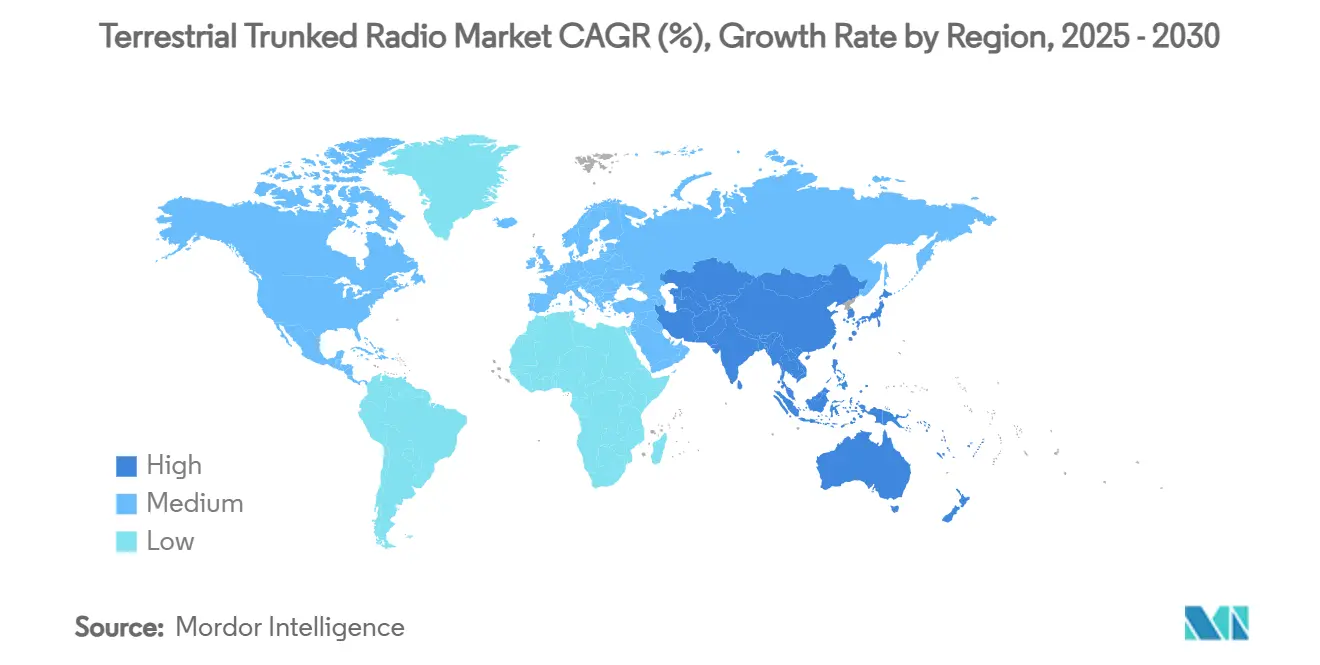
Competitive Landscape
The Terrestrial Trunked Radio market is moderately concentrated. Motorola Solutions leads with USD 10.8 billion revenue in 2024 and a USD 14.7 billion backlog, leveraging an end-to-end portfolio spanning infrastructure to body-worn video. Hytera advances HyTalk PTToC and rugged smart devices to court cost-sensitive buyers, while Sepura focuses on specialized terminals for transportation and utilities. L3Harris and Airbus Secure Land Communications round out the top tier, each maintaining strong defense and public-safety franchises.
Strategic focus centers on hybrid architectures, cybersecurity hardening, and cloud-based fleet management. Vendors increasingly embed dual-mode LTE/TETRA modems and open APIs for third-party app ecosystems. Beyond organic R&D, consolidation shapes the landscape; recent examples include software analytics firms acquired to bolster real-time situational-awareness offerings. Patent filings concentrate on SDR waveform agility and advanced encryption, underscoring a shift toward software-defined differentiation.
Competitive pressure intensifies from cellular ecosystem entrants providing mission-critical services over 5G. Partnerships—such as Samsung with IBM for the UK ESN—signal cross-domain convergence. Established TETRA suppliers counter by offering migration frameworks that preserve existing investments while exposing broadband capabilities. Supply-chain volatility and component tariffs create margin pressure, prompting localization of manufacturing and multi-sourcing strategies to safeguard delivery schedules and cost structures across the Terrestrial Trunked Radio market.
Terrestrial Trunked Radio Industry Leaders
-
Motorola Solutions, Inc.
-
Hytera Communications Corporation Limited
-
Airbus Defense and Space Corporation
-
SEPURA PLC
-
JVCKENWOOD Corporation
- *Disclaimer: Major Players sorted in no particular order
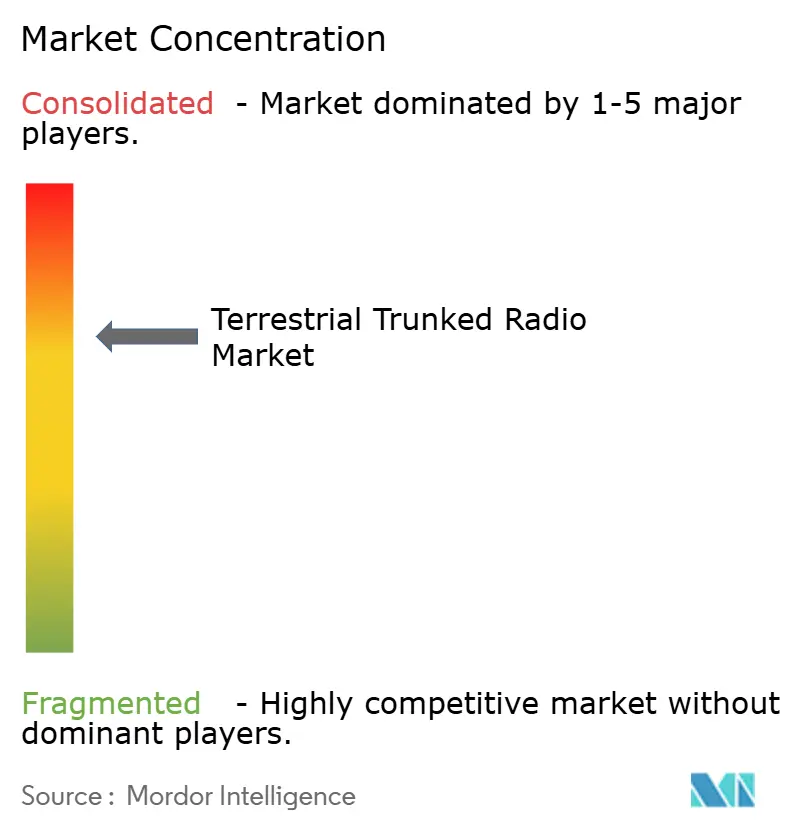
Recent Industry Developments
- January 2025: IBM secured a GBP 1.362 billion contract from the UK Home Office to design the Emergency Services Network, transitioning more than 300,000 responders to 5G infrastructure through 2031.
- January 2025: Samsung Electronics partnered with IBM to supply MCX solutions for the UK ESN rollout.
- December 2024: Motorola Solutions won a NOK 1.78 billion extension to operate Norway’s Nødnett TETRA network until 2031.
- November 2024: Multiple UK fire and rescue services chose Motorola Solutions for a shared Control Room Solution covering 2.5 million residents.
Research Methodology Framework and Report Scope
Market Definitions and Key Coverage
Our study defines the Terrestrial Trunked Radio (TETRA) market as all new digital professional-mobile-radio infrastructure, terminals, and associated software that conform to the ETSI TETRA standard and deliver voice, narrowband data, and short-burst broadband services in mission-critical settings across public safety, transportation, utilities, and industrial campuses. We treat the replacement of legacy analog and proprietary digital radios as addressable demand when the switch is to standard-compliant TETRA systems, and values are expressed in constant 2025 US dollars.
Scope exclusion: legacy analog LMR, P25, DMR, and private LTE solutions are outside the quantified baseline.
Segmentation Overview
- By Mode of Operation
- Trunked Mode Operation (TMO)
- Direct Mode Operation (DMO)
- By Component
- Infrastructure (Base Stations, Switches, Gateways)
- Terminals (Hand-portable, Vehicular, Wearable)
- Software and Services
- By Access Technology
- TETRA Release 1
- TETRA Release 2 / Enhanced Data Service (TEDS)
- Hybrid TETRA-LTE Systems
- By Frequency Band
- 380-410 MHz
- 410-430 MHz
- 800 MHz
- By End-user
- Public Safety and Emergency Services
- Transportation and Logistics
- Utilities and Energy
- Defense and Homeland Security
- Industrial and Commercial (Mining, Oil and Gas, Manufacturing)
- Geography
- North America
- United States
- Canada
- Mexico
- South America
- Brazil
- Argentina
- Rest of South America
- Europe
- United Kingdom
- France
- Germany
- Italy
- Rest of Europe
- Asia Pacific
- China
- Japan
- India
- South Korea
- Rest of Asia Pacific
- Middle East
- Saudi Arabia
- United Arab Emirates
- Turkey
- Rest of Middle East
- Africa
- South Africa
- Nigeria
- Rest of Africa
- North America
Detailed Research Methodology and Data Validation
Primary Research
Interviews were completed with radio system integrators, spectrum regulators, city telecom chiefs, rolling-stock maintainers, and utility dispatch managers across North America, Europe, the Gulf, and East Asia. Discussions clarified refresh cycles, average selling prices, encryption-feature premiums, and infrastructure-to-terminal ratios, enabling us to reconcile secondary gaps and stress-test preliminary figures.
Desk Research
Analysts began with publicly available tier-1 sources such as ETSI base-station deployment filings, ITU spectrum notices, Eurostat capital-goods production tables, FCC license databases, and police and transport budget books in major economies. Industry white papers, lender prospectuses, and national tender portals enriched adoption timelines, while paid repositories, D&B Hoovers for vendor revenue splits and Dow Jones Factiva for network roll-out news, grounded company-level signals. The sources cited above illustrate, not exhaust, the secondary corpus used.
Market-Sizing & Forecasting
A top-down production and trade reconstruction anchors the 2025 baseline. Factory output of TETRA terminals and base-stations from major OEMs is matched with customs codes and adjusted for average channel inventory. Results are corroborated through selective bottom-up checks, sampled public contracts, integrator roll-ups, and ASP times volume benchmarking. Key variables modeled include the analog-to-digital migration rate, public-safety capital spending, urban rail mileage under construction, trunked-mode spectrum allocation, and terminal ASP deflation. Multivariate regression links these drivers to historical sales, and a three-scenario ARIMA overlay captures cyclical replacement surges. Where component-level estimates lacked disclosure, we interpolated using vendor revenue mix averages validated by at-scale integrators.
Data Validation & Update Cycle
Outputs pass variance thresholds versus independent indicators such as ETSI shipment indices and government procurement tallies. Material deviations trigger analyst review, followed by supervisory sign-off. Reports refresh each year, with interim updates when spectrum policy shifts, merger events, or greater than 5 percent spend reallocations occur. A final data sweep is run immediately before client delivery to ensure recency.
Why Mordor's Terrestrial Trunked Radio Baseline Commands Unmatched Reliability
Published estimates differ because firms pick dissimilar scopes, years, and driver sets. Divergence is common when some treat analog upgrades, hybrid LTE roll-outs, or refurbished hardware as part of 'market size,' while others, like us, keep the lens strictly on standard-compliant new builds.
Key gap drivers are usually (a) inclusion of wider LMR technologies, (b) one-off project lumping instead of annualized spending, and (c) currency conversion at spot rather than average rates. Our disciplined scope, variable-level validation, and annual refresh cadence narrow these distortions.
Benchmark comparison
| Market Size | Anonymized source | Primary gap driver |
|---|---|---|
| USD 4.61 bn | Mordor Intelligence | - |
| USD 5.28 bn | Regional Consultancy A | includes hybrid TETRA-LTE systems and refurbishment revenue |
| USD 6.63 bn | Global Consultancy B | folds broader digital LMR plus emergency grant outlays into base year |
In sum, our strictly scoped, driver-aligned, and interview-validated baseline gives decision-makers a dependable starting point, standing apart from figures inflated by peripheral technologies or irregular funding spikes.
Key Questions Answered in the Report
What is the current size of the Terrestrial Trunked Radio market?
The Terrestrial Trunked Radio market reached USD 4.61 billion in 2025 and is projected to hit USD 10.94 billion by 2030.
Which segment leads the Terrestrial Trunked Radio market?
Trunked Mode Operation leads with 63% revenue share in 2024 and is forecast to grow at 19.56% CAGR to 2030.
Why are hybrid TETRA-LTE systems gaining traction?
Hybrid systems marry TETRA’s mission-critical voice reliability with LTE’s broadband data, delivering multimedia capabilities without sacrificing resilience.
Which region is growing fastest in the Terrestrial Trunked Radio market?
Asia Pacific is estimated to grow at the highest CAGR over the forecast period (2025-2030).
Which region has the biggest share in Terrestrial Trunked Radio Market?
Asia Pacific is the fastest-growing region, advancing at a 19.87% CAGR through 2030 due to smart-city initiatives and industrial automation.
How does spectrum refarming influence market growth?
Decommissioning of 2G/3G networks releases sub-1 GHz bands, enabling additional capacity for private mobile radio and stimulating new TETRA deployments.
What challenges impact further TETRA adoption?
High total cost of ownership compared with PoC-over-cellular and the gradual shift toward full-broadband MCX platforms act as primary restraints.
Page last updated on:



